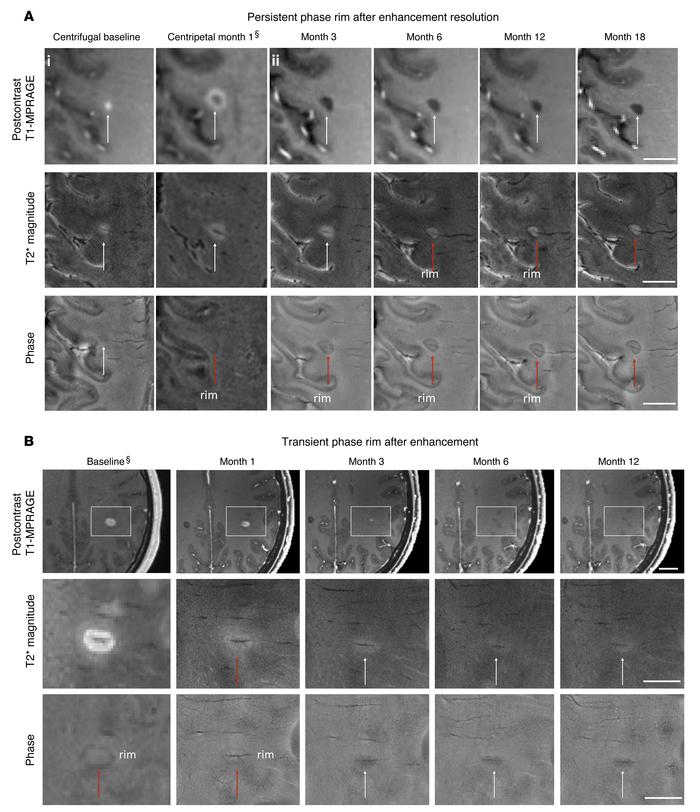MS lesions with an iron halo are slowly expanding and destructive #ResearchSpeak #MSBlog #MSResearch
"Danny Reich, from the NIH, visited our centre a few weeks ago and gave us wonderful talk on the slowly eroding chronic expanding MS lesion. He showed us convincing data on how it differs from other lesions that regress over time. The expanding lesions has a rim of macrophages/microglia on their edges that are actively phagocytosing, or eating, myelin. These lesions are characterised by a prolonged rim of Gd-enhancement and dark rim on MRI that occurs due to in accumulation of iron in macrophages/microglia. These lesions are also more destructive with a tendency to leave being black-holes, which we know are associated with more loss of axons."
"I recall both Cedric Raine and John Prineas, the fathers of the modern MS pathology era, discussing these lesions at length. Cedric always felt these lesions were responsible for the progressive phase of MS. What is interesting is that these lesions don't seem to have prominent T-cell infiltrates; it is as if the macrophages/microglia in these lesions have become independent of T-cell inflammation. The million dollar question is whether or not these microglia are dysregulated or are simply responding appropriately to something in the surrounding tissue. Neuro Doc Gnanapavan suggested that these lesions are like 'granulomas' and that the microglia/macrophages are responding to a foreign protein."
"One of the current hypotheses is that progressive MS is due to 'hot microglia'; the chronic expanding lesion may be the substrate for how microglia lead to progressive MS. It is easy to understand why these lesions won't respond to conventional DMTs, which typically target the adaptive (memory) and not innate immunity (hard-wired). To address this aspect of MS pathology will need drugs that target macrophages/microglia within the CNS. Danny Reich suggested in his talk that in future we may be able to use MRI of individual lesions to assess the efficacy of these drugs. Now if I was a Pharma Scientist I know exactly which classes of drugs I would like to test on these lesions."
 |
| From: Absinta et al. J Clin Invest. 2016;126(7):2597-2609. doi:10.1172/JCI86198. |
 |
| From: Absinta et al. J Clin Invest. 2016;126(7):2597-2609. doi:10.1172/JCI86198. |
Sethi V, Nair G, Absinta M, Sati P, Venkataraman A, Ohayon J, Wu T, Yang K, Shea C, Dewey BE, Cortese IC, Reich DS. SLOWLY ERODING LESIONS IN MULTIPLE SCLEROSIS. MULT SCLER. 2016. PII: 1352458516655403.
BACKGROUND: At autopsy, 20%-40% of chronic multiple sclerosis (MS) lesions are labeled "slowly expanding" and feature myelin phagocytosis at the lesion edge. As pathological lesion classification relies on a single, terminal time point, the rate of lesion expansion cannot be directly measured.
OBJECTIVE: To study long-term volume changes in individual MS lesions.
METHODS: Volumes of individual lesions on proton density magnetic resonance imaging (MRI) acquired between 1992 and 2015 were measured in 22 individuals (one lesion per person). After correction for acquisition protocol, a mixed model evaluated lesion volume changes.
RESULTS: The mean (standard deviation) lesion volume at baseline was 142 (82) mL, falling to 74 (51) mL after 16 (3) years. All lesions shrank over time. Change in lesion volume did not correlate with change in supratentorial brain volume (p = 0.33). In simulations, the results could be explained by a process of slow radial expansion superimposed on substantially more rapid resorption of damaged tissue.
CONCLUSION: We noted sustained radiological contraction of MS lesions, a surprising result given that fresh myelin breakdown products within chronic active lesions are observed relatively frequently at autopsy. Therefore, the primary pathological process in chronic lesions, even those described as "slowly expanding," is likely to be tissue loss.
Absinta et al. Persistent 7-tesla phase rim predicts poor outcome in new multiple sclerosis patient lesions. J Clin Invest. 2016 Jul 1;126(7):2597-609.
BACKGROUND: In some active multiple sclerosis (MS) lesions, a strong immune reaction at the lesion edge may contain growth and thereby isolate the lesion from the surrounding parenchyma. Our previous studies suggest that this process involves opening of the blood-brain barrier in capillaries at the lesion edge, seen on MRI as centripetal contrast enhancement and a colocalized phase rim. We hypothesized that using these features to characterize early lesion evolution will allow in vivo tracking of tissue degeneration and/or repair, thus improving the evaluation of potential therapies for chronic active lesions.
METHODS: Centripetally and centrifugally enhancing lesions were studied in 17 patients with MS using 7-tesla MRI. High-resolution, susceptibility-weighted, T1-weighted (before/after gadolinium), and dynamic contrast-enhanced scans were acquired at baseline and months 1, 3, 6, and 12. For each lesion, time evolution of the phase rim, lesion volume, and T1 hypointensity were assessed. In autopsies of 3 progressive MS cases, the histopathology of the phase rim was determined.
RESULTS: In centripetal lesions, a phase rim colocalized with initial contrast enhancement. In 12 of 22, this phase rim persisted after enhancement resolved. Compared with centripetal lesions with transient rim, those with persistent rim had less volume shrinkage and became more T1 hypointense between months 3 and 12. No centrifugal lesions developed phase rims at any time point. Pathologically, persistent rims corresponded to an iron-laden inflammatory myeloid cell population at the edge of chronic demyelinated lesions.
CONCLUSION: In early lesion evolution, a persistent phase rim in lesions that shrink least and become more T1 hypointense over time suggests that the rim might mark failure of early lesion repair and/or irreversible tissue damage. In later stages of MS, phase rim lesions continue to smolder, exerting detrimental effects on affected brain tissue.